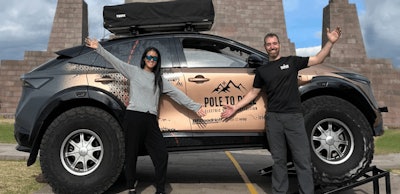
Toronto, Ontario — In this weekly electric and autonomous vehicle report, an electric vehicle has completed the first ever drive from the magnetic North Pole to South Pole; while autonomous robot, Parkie aims to help make vehicle parking become more efficient.
Shoot for the Pole
Scottish adventurers, Chris and Julie Ramsey recently completed their nine-month and 17,000-mile “Pole to Pole EV” expedition, an adventure that marks the world’s first drive from the 1823 magnetic North Pole to South Pole.
The couple have also set a record for making the entire trek in an electric vehicle. Chris and Julie Ramsey performed the journey in a Nissan Ariya e-40RCE EV, which was modified by Icelandic specialist Arctic Trucks to be able to withstand the demands of the trip.
The main upgrades made to the electric vehicle included larger 39-inch tires as well as matching wheel arches and ice-friendly gear and body reinforcement work. The powertrain and suspension, however, were mostly stock but did receive a lifted height to help protect from ice damage.
The extra load on the EV due to upgrades and the Ramsey’s supplies meant that the couple had to make due with a reduced driving range of just 150 to 200 miles—a decrease from the original 272.
During the Arctic and Antarctic portions of the trip, the Ramseys picked up strategies for keeping the vehicle’s warm. These strategies included piling up a snow wall to shield the vehicle’s underside and front radiator from the wind, as well as using a tent to cover the whole vehicle when it wasn’t too windy.
Depending on the weather, the Ramseys would use either a 5kW wind turbine or a prototype solar hybrid charging solution for the Ariya. Failing these methods, the couple would have to fall back on a petrol generator, but tried to use this as little as possible.
Chris Ramsey originally explained to Expedition Portal that the purpose of the trek was to “prove that electric vehicles make a viable replacement for existing diesel-powered expedition vehicles in polar regions.”
The couple completed their trek on December 15, 2023, but could only share their success after re-establishing satellite connection later on.
Robot ready
A self-parking robot named Parkie took home a technology award at the 2024 Consumer Electronics Show (CES) for its proposed capacity to help make vehicle parking more efficient.
Created by the Korean mobility and technology specialist HLmando, the skateboard-like machine claims to employ Level 4 autonomous driving technology to recognize objects, tires and license plates to then independently assess parking space availability without the need for additional infrastructure.
Parkie the robot stands at just 3.5 inches high to allow it to work with most commonly used vehicles by sliding under the cars and then lifting, rotating, and driving them to a parking space that is so tight, the vehicle’s doors cannot open.
HLmando claims that its invention can liberate an additional 30 percent of parking spaces in congested areas by parking vehicles closer together than a human driver would be able to achieve.
To function properly, the driver would exit their vehicle and then, like a valet, Parkie the robot would take their vehicle and fit it into a free parking space.
The design is scheduled to commence testing in April of this year at a start-up hub outside of Seoul, Korea. The testing will include trials working in busy multi-story car parks.






















